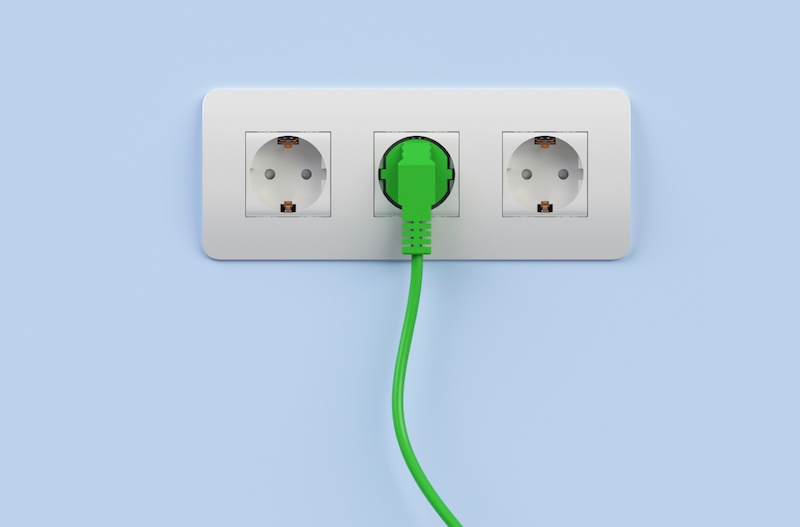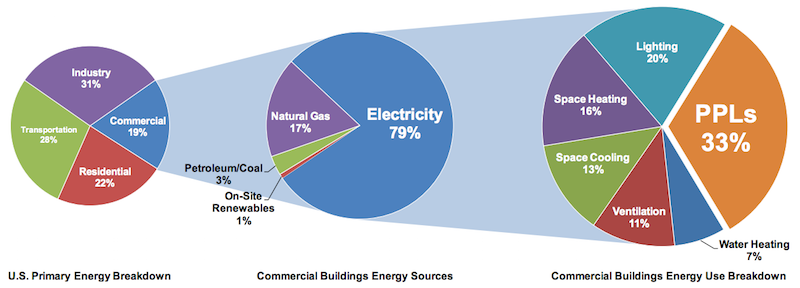
It’s time your facility gets a grip on its plug load management.
According to the Department of Energy, overall energy consumption by commercial buildings will increase 24% by 2030. Additionally, plug and process loads (PPLs) will increase by 49%.
Currently, the energy use breakdown in commercial buildings is as follows:
- Water Heating: 7%
- Ventilation: 11%
- Space Cooling: 13%
- Space Heating: 16%
- Lighting: 20%
- PPLs: 33%

Image via NREL
Interested in saving energy (and money), the Department of Energy’s National Renewable Energy Laboratory (NREL) implemented plug load reduction measures and ended up reducing PPL energy use by 43%, thereby saving $58,000 annually.
So what plug load control measures can you take to reduce energy consumption and overall facility maintenance expenses? Read NREL’s process below to find out!
1. Assign a Team Member to Oversee the Plug Load Control Project
In order to effectively reduce your PPL expenses, you’ll need to make sure someone takes ownership of your organization’s efforts. NREL believes this person “needs to understand basic energy efficiency opportunities and design strategies and be able to independently and objectively apply cost justifications.”
Furthermore, this team member “must be willing and able to critically evaluate, address, and influence the building’s operations, institutional policies, and procurement processes” as well as ensure all decision makers are on the same page.
2. Institutionalize PPL Measures
In order to see real savings, plug load reduction measures must be institutionalized through policy programs and procurement decisions.
3. Benchmark
First, conduct a walkthrough of your facility to assess and inventory current PPLs. You’ll also want to find out how and why each device is used.
Next you’ll want to develop a metering plan to identify energy-saving strategies. The data you collect can be used to find out when equipment is used and when it can be turned off. To help you with your efforts, use a plug load power meter.
Last but not least, meter the plug loads. This will allow you to establish a benchmark of current operations and equipment and calculate the average load during nonbusiness and business hours.
4. Develop a Business Case
Like with any new venture, the team member overseeing the project will have to justify why taking measures to reduce PPLs is important to the organization.
Make sure energy savings as well as non-energy benefits are highlighted.
5. Distinguish Between True and Perceived Needs
According to NREL:
A true need is required to achieve a given business function; a perceived need is often based on past experience without consideration for more efficient strategies to accomplish the same function.
Determining the true needs of those using facility equipment will reveal any nonessential equipment and/or operations.
6. Meet Needs
Once true needs are determined, meet them in the most efficient way possible (i.e. energy-efficient equipment, turning off equipment when not in use, etc.).
7. Turn It Off!
According to NREL, “office buildings are unoccupied for two-thirds of the year.” That means there’s a lot of energy savings to be had by reducing energy during nonbusiness hours.
8. Monitor Third Party Use
While some of your organization’s equipment might be used solely by outside vendors or contractors, you still cover the energy costs. Therefore, it’s important to “contractually require or provide the most efficient equipment available.”
9. Promote Awareness
Want to really make a dent in energy savings? By promoting awareness surrounding energy efficiency best practices, your team members will understand why it’s important and be more likely to comply.
10. Get the Design Team Involved
As NREL points out, “New construction and retrofit projects bring additional PPL reduction opportunities that the design team should address.” Together, your person running point on the project and the design team can maximize space efficiency, integrate PPL control strategies, and specify energy-efficient equipment.
What measures have you implemented to reduce plug and process loads?



